Feb 2, 2021 | Environment, Poverty & Equity, Risk and resilience, Young Scientists
By Prakash Khadka, IIASA Guest Research Assistant and Wei Liu, Guest Research Scholar in the IIASA Equity and Justice Research Group
Prakash Khadka and Wei Liu explain how unbridled, unplanned infrastructure expansion in Nepal is increasing the risk of landslides.
Worldwide, mountains cover a quarter of total land area and are home to 12% of the world’s population, most of whom live in developing countries. Overpopulation and the unsustainable use of these fragile landscapes often result in a vicious cycle of natural disaster and poverty. Protecting, restoring, and sustainably using mountain landscapes is an important component of Sustainable Development Goal 15 ̶ Life on Land ̶ and the key is to strike a balance between development and disaster risk management.
Nepal is among the world’s most mountainous countries and faces the daunting challenge of landslides and flood risk. Landslide events and fatalities have been increasing dramatically in the country due to a complex combination of earthquakes, climate change, and land use, especially the construction of informal roads that destabilize slopes during the monsoon.
According to Nepal government data, 476 incidents of landslides and 293 fatalities were recorded during the 2020 monsoon season – the highest number in the last ten years, mostly triggered by high-intensity rainfall – a trend which is increasing due to climate variations. According to one study, by mid-July 2020, the number of fatal landslides for the year had already exceeded the average annual total for 2004–2019.
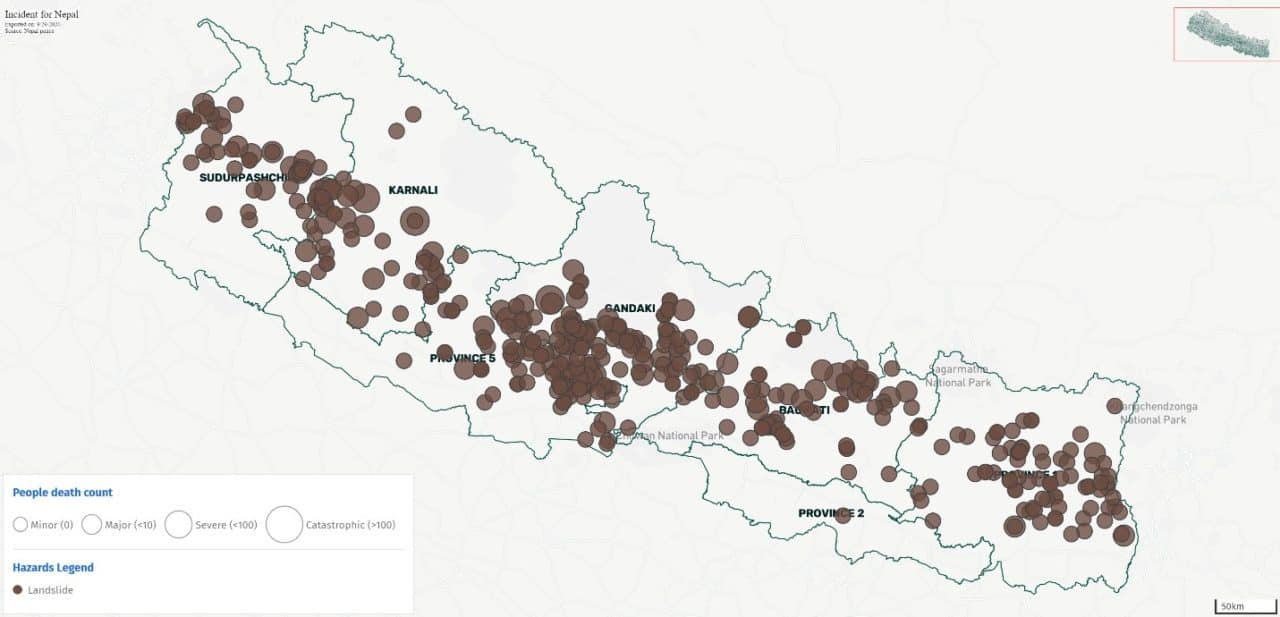
Figure 1: A map of landslide events in Nepal from June to September 2020. Source: bipadportal.gov.np
Landslides are not a new phenomenon in the country where hills and mountains cover nearly 83% of the total land area. While being destructive, landslides are complex natural processes of land development. The Gangetic plain, situated in the foothills of the Himalayas, was formed by the great Himalayan river system to which soil is continually added by landslides and deposited at the base by rivers. Mountain land changes via natural geo-tectonic and ecological processes has been happening for millions of years, but fast population growth and climate change in recent decades substantially altered the fate of these mountain landscapes. Road expansion, often in the name of development, plays a key role.
Many mountain areas in Nepal are physically and economically marginalized and efforts to improve access are common. Poverty, food insecurity, and social inequity are severe, and many rural laborers opt to migrate for better economic opportunities. This motivates road network expansion. Since the turn of the century, Nepalese road networks has almost quadrupled to the current level of ~50 km per 100 km2, among which rural roads (fair-weather roads) increased more than blacktop and gravel roads.
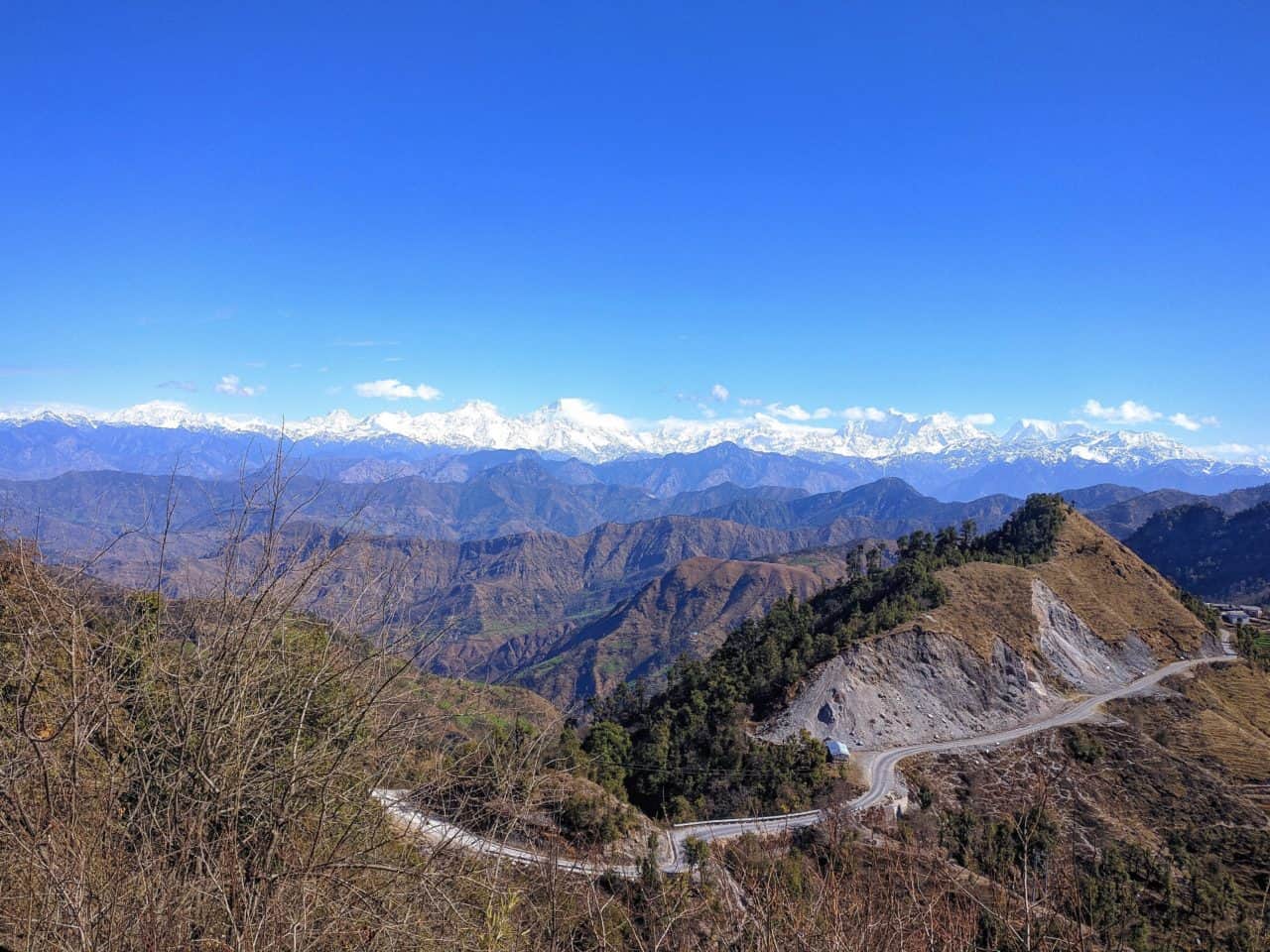
Figure 2: Mountains carved just above Jay Prithvi Highway in Bajhang district of Sudurpaschim province to build a road
Nepalese mountain roads are treacherous and subject to accidents and landslides. Rural roads, which are often called “dozer roads”, are constructed by bulldozer owners in collaboration with politicians at the request of communities (also as part of the election manifesto in which politicians promised road access in exchange for votes and support to win), often without proper technical guidance, surveying, drainage, or structural protection measures. In addition, mountains are sometimes damaged by heavy earthmovers (so-called “bulldozer terrorism”) that cut out roads that lead from nowhere to nowhere, or where no roads are needed, at the expense of economic and environmental degradation. Such rapid and ineffective road expansion happens throughout the country, particularly in the middle hills where roads are known to be the major manmade driver of landslides.
To tackle these complexities, we need to rethink how we approach development in light of climate change. This has to be done with sufficient investigation into our past actions. The Nepalese Community forestry management program, which emerged as one of the big success stories in the world, encompasses well defined policies, institutions, and practices. The program is hailed as a sustainable development success with almost one-third of the country’s forests (1.6 million hectares) currently managed by community forest user groups representing over a third of the country’s households. Another successful example is the innovation of ropeways and its introduction in the Bhattedanda region South of Kathmandu. The ropeways were instrumental in transforming farmers’ lives and livelihoods by connecting them with markets. Locals quickly mastered the operation and management of the ropeway technology, which was a lifesaver following the 2002 rainfall that washed away the road that had made the ropeway redundant until then.
These two examples show that it is possible to generate ecological livelihoods for several households in Nepal without adversely affecting land use and land cover, which in turn contributes to increased landslide risk in the country, as mentioned above.
A rugged landscape is the greatest hindrance to the remote communities in a mountainous country like Nepal. It cannot be denied that the country needs roads that serve as the main arteries for development, while local innovations like ropeways can well complement the roads with great benefits, by linking remote mountain villages to the markets to foster economic activities and reduce poverty. Such a hybrid transportation model is more sustainable economically as well as environmentally.
It is a pity that despite strong evidence of the cost-effectiveness of alternative local solutions, Nepal’s development is still mainly driven by “dozer constructed roads”. Mountain lives and livelihoods will remain at risk of landslides until development tools become more diverse and compatible.
References:
- Gyawali, D. (Ed.), Thompson, M. (Ed.), Verweij, M. (Ed.). (2017). Aid, Technology and Development. London: Routledge, https://doi.org/10.4324/9781315621630
- Gyawali, Dipak; Dixit, Ajaya; Upadhya, Madhukar (2004). Ropeways in Nepal.
- Petley, D. N. (2020). The deadly start to the monsoon season in Nepal – The Landslide Blog – AGU Blogosphere. The Landslide Blog. https://blogs.agu.org/landslideblog/2020/07/24/nepal-2020/
Note: This article gives the views of the author, and not the position of the Nexus blog, nor of the International Institute for Applied Systems Analysis.
Dec 7, 2020 | Biodiversity, Climate Change, Food & Water, Women in Science, Young Scientists
By Shorouk Elkobros, 2020 IIASA Science Communication Fellow
Being mindful of biodiversity loss and environmental impact can disrupt the beef industry globally, here’s how.
In his new polemical Netflix documentary, A life on our planet, Sir David Attenborough argues that, “We live on a finely tuned life support machine, one that relies on its biodiversity to run smoothly.”
The decline in biodiversity challenges the world’s capacity to produce food for a growing population. That is ironic when global food production itself is a contributing factor to biodiversity loss, especially beef production.
What’s wrong with the beef industry?
Here are a couple of the current challenges facing the beef industry: Cows are major culprits in climate change because they emit methane, a potent greenhouse gas. Beef production is the number one driver of deforestation and habitat loss in tropical forests. Grazing cattle also require a large amount of grass that requires using harsh nitrogen fertilizers. Hence, the beef production industry contributes heavily to biodiversity loss, which has dire consequences for the planet.
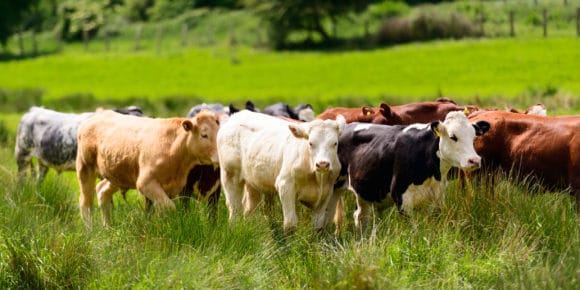
©Jonathan Casey | Dreamstime.com
There is no silver bullet to solve the challenges beef production poses to the environment. Research is going above and beyond to find diverse and integrated solutions that can go hand in hand to combat this challenge. Whether through ways to reduce methane emissions, such as creating an anti-burp vaccine for cows, designing lab-grown meat, or shifting diets to plant-based alternatives.
Katie Lee, an alumna of the 2020 IIASA Young Scientists Summer Program (YSSP) and PhD student at the University of Queensland in Brisbane, Australia, is part of a broader project that focuses on redistributing where we produce beef to minimize its impact on greenhouse gas emissions and biodiversity, as well as on the cost of production.
“I am particularly interested in ways to enhance the types of beef production systems. With the challenges of its water use, greenhouse gas emissions, and the large areas of land it requires compared to any other food source, any small changes we propose can have a big impact,” she explains.
For Lee, solutions to global food security are crucial, and looking at the status of production systems is both a need and a must. The world population is expected to reach 9.7 billion people by 2050. So, when thinking about ways to feed 10 Billion people by 2050, it becomes clear that it is not enough to simply look at beef alternatives without enhancing its current demand and supply chains. Lee thinks it is more efficient to pragmatically alter and improve the environmental impact of beef production than to convince people to stop eating beef.
It is understood that reducing beef consumption has health benefits. However, with a growing interest in alternative meat options, the question remains of which markets this appeals to, and how environmentally friendly and energy- and water intensive these alternatives are.
“While demand reduction on meat is important, sometimes it is not feasible in countries that do not have economic security or are still growing in terms of affluence, which leads to an increase in beef consumption. That is why we need to look at the producer side and the consumer side, as well as everything in between to have the biggest impact. I was particularly interested to conduct this research in cooperation with IIASA, mainly because the institute has a good history of looking at the impact of beef, particularly in terms of greenhouse gas emissions,” says Lee.
A win-win all-round solution
Using the IIASA Global Biosphere Management Model (GLOBIOM), Lee is assessing the impact on greenhouse gas emissions and biodiversity when shifting both the production and demand of beef. Preliminary results from her ongoing study show a reduction in impact on biodiversity and greenhouse gas emissions, as well as a reduction of the producer price when switching away from extensive grazing systems ̶ a win-win situation all-round.
“Few studies explicitly address biodiversity loss compared to investigating ways to reduce greenhouse gas emissions. I want to show stakeholders that beef production can be more efficient in terms of reducing its impact on greenhouse gas emissions and biodiversity. I am hopeful that this study can help beef producers to be mindful of this when making choices. That will be a win for the environment if it goes together with a proactive reduction of meat consumption,” concludes Lee.
Similar to Lee’s study and using a set of large-scale economic models including GLOBIOM, the IIASA AnimalChange research project aims to assess the global scale adaptation and mitigation options of the livestock sector to ensure a sustainable livestock production sector by 2050.
Limiting global warming and protecting biodiversity should be a priority when designing food systems able to feed an increasing population. As a food producer, whether you raise cattle or design cell cultured meat, it is important to be conscious about livestock hoof prints on biodiversity. As a food consumer, it is necessary to be mindful of having a healthy and sustainable diet that does not put the planet in jeopardy. Sustainable beef production might not be the panacea to future biodiversity loss or food scarcity, yet it can offer a significant change.
Note: This article gives the views of the author, and not the position of the Nexus blog, nor of the International Institute for Applied Systems Analysis.
Nov 20, 2020 | Climate Change, Risk and resilience, Young Scientists
By Greg Davies-Jones, 2020 IIASA Science Communication Fellow
Greg Davies-Jones sits down with 2020 IIASA Young Scientists Summer Program (YSSP) participant Lisa Thalheimer to discuss how attribution science can play a leading role in addressing disaster displacement.
We live in the era of the greatest human movement in recorded history – there are more people on the move today than at any other point in our past. Despite the common misconception that most migrants cross borders, a lot of migration actually occurs internally. According to the Internal Displacement Monitoring Center, a staggering 72% of internal migration is linked to displacement due to natural hazards or extreme weather.
Pinpointing the finer details of how human mobility might evolve remains a complex undertaking. Contemporary migratory movements reflect the complex patterns of social and economic globalization – they flow in all directions and affect all countries in one way or another. It is clear that given the rising global average temperatures, natural hazards and extreme weather events will increase in frequency, intensity, and duration, adversely effecting many parts of the globe. A better understanding of how human-induced climate change influences disaster displacement will undoubtedly be essential in addressing future human mobility and informing the debate on climate and migration policies.
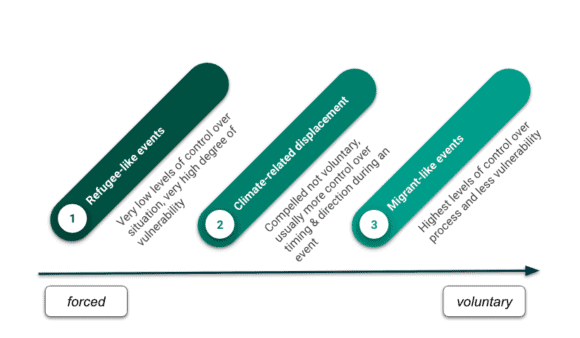
Figure: Climate-related displacement on an axis of forced to voluntary human mobility. Thalheimer (2020)
The focus of 2020 YSSP participant Lisa Thalheimer’s research is on internal displacement in East Africa, in particular, Somalia. As part of her YSSP project, Thalheimer hopes to determine whether, and to what extent, human-induced climate change altered the likelihood of extreme weather-related displacement in Somalia by conflating econometric methods and Probabilistic Event Attribution (PEA).
“Econometrics is essentially the application of statistical methods to quantify impacts and PEA is a way of examining to what extent extreme weather events can be linked with past man-made emissions. By combining the two methods we hope to quantify the ramifications of extreme weather and displacement in East Africa,” she explains.
This is no mean feat, as PEA itself is a relatively new science and many challenges still exist in the field of event attribution ̶ a field of research concerned with the process by which the causes of behavior and events can be explained. In this instance, the idea was to study each extreme weather event individually to determine if human-induced climate change may have added to the intensity or likelihood of the event occurring. PEA is a growing science within this field and relies on the availability of long-term meteorological observations and the reliability of climate model simulations. In terms of migration and the accompanying econometric methods, the complexity of this work is mainly in data capturing.
“The difficulty with migration data capturing is at the start – before you can capture anything, you must ascertain how the data is defined, as different countries define mobility in different ways. For instance, it could be time – where did you live one year ago as opposed to five years ago? That’s the first complexity. Then you must work out who collects data on who – in Europe, we have fundamental freedom of movement within the EU, so unless you file for residency, your movement is not recorded. Another complexity is because we want to see if climate change is part of the driver ̶ directly or indirectly. We need to know not just where people are now, but where they have been and where they came from, so we can match the climate with their movements. All of this highlights how difficult it is to carry out this type of analysis,” Thalheimer adds.
In Somalia, the team relied on previously collected forced migration data, for example, from the UN High Commissioner for Refugees (UNHCR). These UNHCR datasets collected in Somalia were comprehensive and included not only origin and destination information but also a categorization of the primary reason for the displacement.
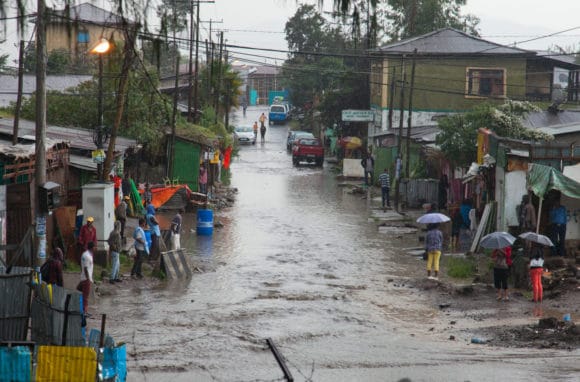
© Aleksandr Frolov | Dreamstime.com
The investigation homed in on one extreme weather case study in the region: The April 2020 heavy rainfall in Southern Ethiopia, which led to several severe flooding events in South Somalia. In this particular case, however, no appreciable connection could be made between human-induced climate change and the resultant displacement. Despite this somewhat chastening outcome, the achievement of this study is not proving a definitive attributable link between human-induced climate change and the April 2020 rainfall, but rather the construction of the adjustable attribution framework presented that can be applied directly to other events and displacement contexts.
As previously mentioned, there are, however, limitations to this novel methodology, especially in regions like Somalia that lack exhaustive observational weather and displacement data. According to Thalheimer, exploring ways of effectively applying this framework in countries vulnerable to climate change will be particularly important going forward.
“Event attribution studies do not usually form the basis of climate migration analysis, disaster risk reduction, or adaptation strategies. Yet, to respond appropriately to these impacts and affected populations, we must develop a comprehensive and detailed understanding of the nature of these impacts, as well as knowledge on how these might evolve over time. Event attribution is a tool we can employ to do this,” she concludes.
Note: This article gives the views of the author, and not the position of the Nexus blog, nor of the International Institute for Applied Systems Analysis.
Nov 10, 2020 | Air Pollution, China, Climate Change, Energy & Climate, Young Scientists
By Xu Wang, IIASA Young Scientists Summer Program (YSSP) alumnus and Assistant Professor at Beijing University of Technology and Pallav Purohit, researcher in the IIASA Air Quality and Greenhouse Gases Program.
Xu Wang and Pallav Purohit write about their recent study in which they found that accelerating the transition to climate-friendly and energy-efficient air conditioning in the Chinese residential building sector could expedite building a low-carbon society in China.

© Shao-chun Wang | Dreamstime.com
China saw the fastest growth worldwide in energy demand for space cooling in buildings over the last two decades, increasing at 13% per year since 2000 and reaching nearly 400 terawatt-hours (TWh) of electricity consumption in 2017. This growth was largely driven by increasing income and growing demand for thermal comfort. As a result, space cooling accounted for more than 10% of total electricity growth in China since 2010 and around 16% of peak electricity load in 2017. That share can reach as much as 50% of peak electricity demand on extremely hot days, as seen in recent summers. Cooling-related carbon dioxide (CO2) emissions from electricity consumption consequently increased fivefold between 2000 and 2017, given the strong reliance on coal-fired power generation in China [1].
In our recent publication in the journal Environmental Science and Technology, we used a bottom-up modeling approach to predict the penetration rate of room air conditioners in the residential building sector of China at the provincial level, taking urban-rural heterogeneity into account. Our results reveal that increasing income, growing demand for thermal comfort, and warmer climatic conditions, could drive an increase in the stock of room air conditioners in China from 568 million units in 2015 to 997 million units in 2030, and 1.1 billion units in 2050. In urban China, room air conditioner ownership per 100 households is expected to increase from 114 units in 2015 to 219 units in 2030, and 225 units in 2050, with slow growth after 2040 due to the saturation of room air conditioners in the country’s urban households. Ownership of room air conditioners per 100 households in rural China could increase from 48 units in 2015 to 147 units in 2030 and 208 units in 2050 [2].
The Kigali Amendment to the Montreal Protocol on Substances that Deplete the Ozone Layer will help protect the climate by phasing down high global warming potential (GWP) hydrofluorocarbons (HFCs), which are commonly used as refrigerants in cooling technologies [3]. Promoting energy efficiency of cooling technologies together with HFC phase-down under the amendment can significantly increase those climate co-benefits. It is in this context that we assessed the co-benefits associated with enhanced energy efficiency improvement of room air conditioners (e.g., using efficient compressors, heat exchangers, valves, etc.) and the adoption of low-GWP refrigerants in air conditioning systems. The annual electricity saving from switching to more efficient room air conditioners using low-GWP refrigerants is estimated at almost 1000 TWh in 2050 when taking account of the full technical energy efficiency potential. This is equivalent to approximately 4% of the expected total energy consumption in the Chinese building sector in 2050, or the avoidance of 284 new coal-fired power plants of 500 MW each.
Our results indicate that the cumulative greenhouse gas mitigation associated with both the electricity savings and the substitution of high-GWP refrigerants makes up 2.6% of total business-as-usual CO2 equivalent emissions in China over the period 2020 to 2050. Therefore, the transition towards the uptake of low-GWP refrigerants is as vital as the energy efficiency improvement of new room air conditioners, which can help and accelerate the ultimate objective of building a low-carbon society in China. The findings further show that reduced electricity consumption could mean lower air pollution emissions in the power sector, estimated at about 8.8% for sulfur dioxide (SO2), 9.4% for nitrogen oxides (NOx), and 9% for fine particulate matter (PM2.5) emissions by 2050 compared with a pre-Kigali baseline.
China can deliver significant energy savings and associated reductions in greenhouse gas and air pollution emissions in the building sector by developing and implementing a comprehensive national policy framework, including legislation and regulation, information programs, and incentives for industry. Energy efficiency and refrigerant standards for room air conditioning systems should be an integral part of such a framework. Training and awareness raising can also ensure proper installation, operation, and maintenance of air conditioning equipment and systems, and mandatory good practice with leakage control of the refrigerant during the use and end-of-life recovery. Improved data collection, research, and cooperation with manufacturers can equally help to identify emerging trends, technology needs, and energy efficiency opportunities that enable sustainable cooling.
References:
[1] IEA (2019). The Future of Cooling in China: Delivering on Action Plans for Sustainable Air Conditioning, International Energy agency (IEA), Paris.
[2] Wang X, Purohit P, Höglund Isaksson L, Zhang S, Fang H (2020). Co-benefits of energy-efficient air conditioners in the residential building sector of China, Environmental Science & Technology, 54 (20): 13217–13227 [pure.iiasa.ac.at/16823]
[3] Purohit P, Höglund-Isaksson L, Dulac J, Shah N, Wei M, Rafaj P, Schöpp W (2020). Electricity savings and greenhouse gas emission reductions from global phase-down of hydrofluorocarbons, Atmospheric Chemistry and Physics, 20 (19): 11305-11327 [pure.iiasa.ac.at/16768]
Note: This article gives the views of the author, and not the position of the Nexus blog, nor of the International Institute for Applied Systems Analysis (IIASA).
Oct 16, 2020 | Systems Analysis, Young Scientists
By Greg Davies-Jones, 2020 IIASA Science Communication Fellow
Greg Davies-Jones delves into the topic of Capacity Development at IIASA and what the institute hopes to achieve in the coming years.
Capacity development is an essential process in any ambitious organization. This is no different at IIASA. As an institute widely recognized for its global, non-partisan, policy-orientated research, it strives to stay ahead of the curve. IIASA prides itself on the diversity of its staff, while also remaining mindful of a variety of other, equally critical aspects such as organizational capability, impact, and influence. Given the magnitude of today’s global challenges, allied with the diversity of modern research, systems thinking has never had greater value, nor greater potential. Now more than ever, IIASA is needed.

© Crazy Media | Dreamstime.com
Leading the charge is Fabian Wagner, Dean of Capacity Development and Academic Training (CDAT) – a role that he fulfills in tandem with his responsibilities as a senior researcher in the IIASA Air Quality and Greenhouse Gases Program.
“A priority for IIASA is nurturing the next generation of system analysts. This does not mean we are aiming for a particular number over a given period but rather it’s about making sure our research has maximum impact and being more strategic with how we deliver external expertise – streamlining CDAT helps that,” explains Wagner. “It’s similar to how we look at effectively using aid money – you don’t give to provide superficial solutions, you facilitate the actions needed to help people permanently solve problems. At IIASA this means if your country needs three people to carry out some technical assessment and our three people are busy, we can offer our tools and expertise to help you train three of your own people to carry out the analysis.”
An initiative at the forefront of broadening participation in systems analysis is the institute’s flagship Young Scientists Summer Program (YSSP). This program, alongside the numerous IIASA postdoc opportunities, is a major building block for capacity development at the institute.
Every summer, a diverse mix of early-career scientists assemble at an 18th-century castle in Laxenburg, just outside Vienna, Austria – the institute’s headquarters – to spend three months working on a range of topics derived from and complementary to ongoing research being carried out as part of the IIASA research agenda. In parallel with the research endeavors, a program of activities and events ensure that YSSP participants spend the summer months being not solely scientifically stimulated, but professionally and culturally as well: Extending their professional networks; discovering Vienna’s cultural treasure-trove, and making a heap of new friends along the way. This interaction between IIASA and YSSP participants forms the beginning of a valued relationship that has the potential to facilitate further research, collaboration, and indeed positive action in the years to come.
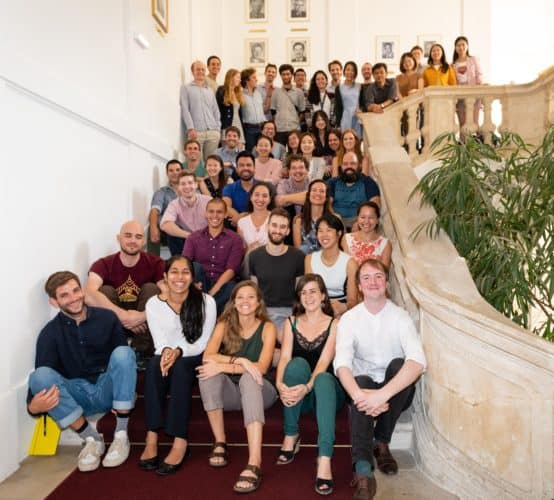
© Christoph Liebentritt | IIASA
IIASA aims to expand its portfolio for early-career professionals beyond the YSSP and post-doc initiatives. In the coming years, the institute hopes to add a range of internships and fellowships to complement the current early-career opportunities: ” To really make bigger changes in the world, we need to broaden and deepen the understanding of systems science and also expand our networks,” affirms Wagner.
Wagner says that capacity development at the institute will lead to greater external value. An illustration of how this would serve as a catalyst for valuable, trans-national impact is the scope for increased interaction with the UN Sustainable Development Goals (SDGs).
“Globally, there is a raft of organizations offering foundational courses on the SDGs and how to achieve them. IIASA, likewise, contributes to this endeavor, not only to offer a basic understanding of the SDGs but specifically to delve into what the synergies and tradeoffs may be. Enhancing capability and developing strategic outlets to provide such outreach programs at the institute will boost external value and drive international impact,” Wagner adds.
Coupled with this fresh outlook on capacity development, IIASA recently finalized its plans for a new strategy that will ensure it continues to uphold its directive to provide independent, science-based insights to underscore systems capable of addressing global challenges over the next decade. This roadmap for the future of systems analysis at IIASA will run in tandem with capacity development. Driving both forward concurrently will, of course, require some give and take.
“This will likely result in a broader mandate at IIASA, which means more people engaging in capacity development activities and thus potentially proportionately fewer hours spent on research but, crucially, it will ensure our research has real impact. Notwithstanding, this does not necessarily mean that it is always a zero-sum game but rather a chance to create new opportunities elsewhere. Our people have different skills and are driven to engage in different activities. It is therefore about harnessing those skills and that drive and employing those attributes in the most suitable context. Ultimately, it is about creating more opportunities – that is how I see my role – as a new opportunity to create new opportunities,” concludes Wagner.
Applications for the 2021 YSSP are now open, apply here.
Note: This article gives the views of the author, and not the position of the Nexus blog, nor of the International Institute for Applied Systems Analysis.
Aug 26, 2020 | Alumni, Climate Change, History, USA, Young Scientists
By Marcus Thomson, IIASA alumnus and a researcher at the National Center for Ecological Analysis and Synthesis (NCEAS), the University of California, Santa Barbara
IIASA alumnus Marcus Thomson explains how what we have learnt about prehistoric farming cultures can be used to provide useful insights on human societal responses to climate change.
The climate of the western half of the North American continent, between the Rocky Mountains and the Pacific coastal region, is dry by European standards. The American Southwest, in particular, centered roughly on the intersection of the states of Colorado, New Mexico, Arizona, and Utah, is predominantly desert between high mountain plateaus. It is, and has always been, a challenging environment for farmers. Yet the prehistoric Southwest was home to complex maize-based agricultural societies. In fact, until the 19th century growth of industrial cities like New York, the Southwest contained ruins of the largest buildings north of Mexico — and these had been abandoned centuries before the Spanish arrived in the Americas.
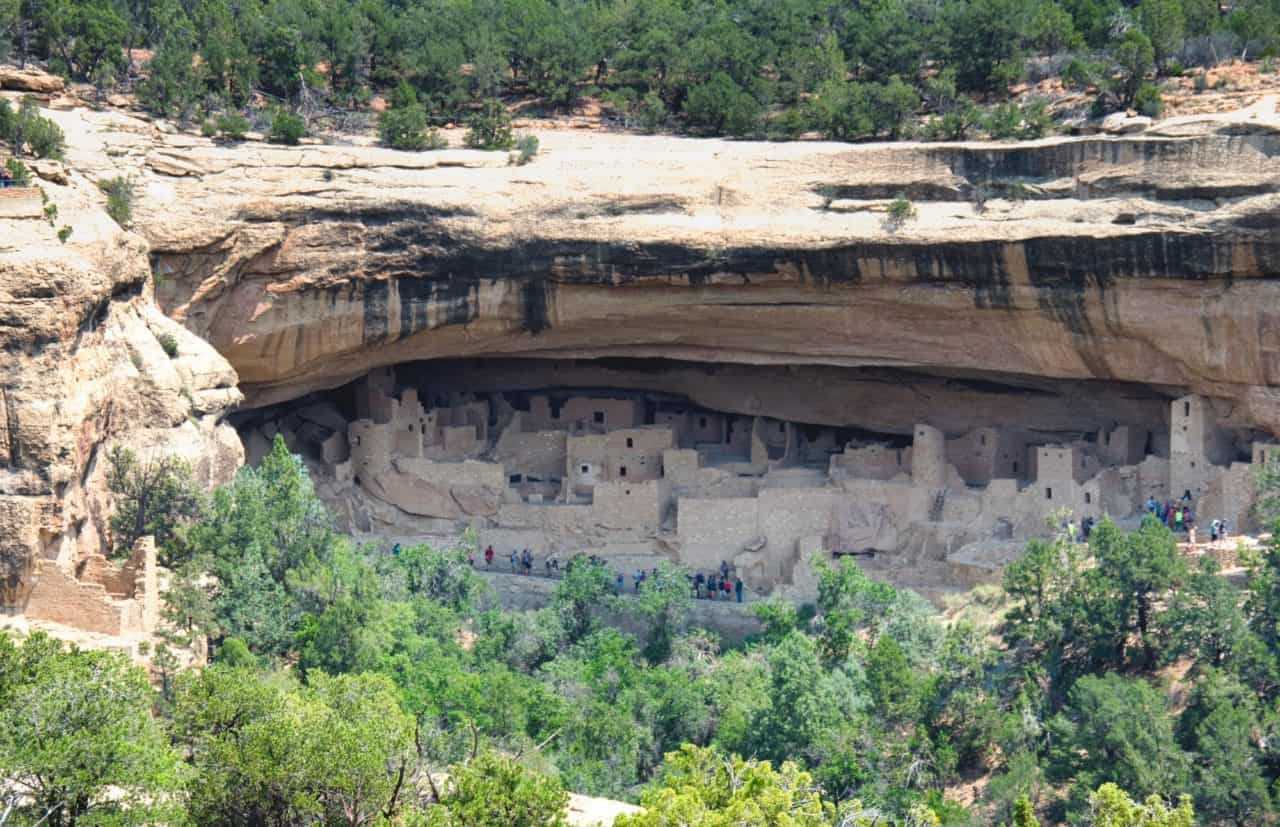
© Mudwalker | Dreamstime.com
For more than a century, researchers have pored over data, from proxies of paleo-environmental change, to historiographies collected by explorers, to archaeology and computational models of human occupation, and produced a detailed picture of the socio-environmental, economic, and climatic conditions that could explain why these sites were abandoned. While details vary in fine-grained analyses of the various sub-groupings of peoples in the region, the big picture is one of societal transformation in adapting to climate change.
Also important is just how the climate changed during the period, because similar dynamics are expected to emerge in the future as a consequence of global warming. European historians point to a medieval era with generally warmer mean annual temperatures. In the Southwestern United States however, which is more sensitive to changes in drought than temperature, the period between roughly AD 850 to 1350 is known as the Medieval Climate Anomaly (MCA). The warm, dry MCA was followed by a long stretch of increased changes in the availability of water, known as the Little Ice Age (LIA). More frequent “warm droughts” at the end of the MCA, and generally increasing changes in water resources at the onset of the LIA, is thought to be a good analogy for future conditions in western North America.
When I had the good fortune to visit IIASA as a participant of the Young Scientists Summer Program (YSSP) in 2016, I worked with research scholars Juraj Balkovič and Tamás Krisztin to develop a model of ancient Fremont Native American maize. The Fremont were an ancient forager-farmer people who lived in the vicinity of modern Utah. We used a climate model reconstruction of the temperature and rainfall between AD 850 and 1450 to drive this maize crop model, and compared modeled crop yields against changes in radiocarbon-derived occupations – in other words, the information gathered from carbon dated artifacts that show that an area was occupied by a particular people – from a few archaeological areas in Utah.
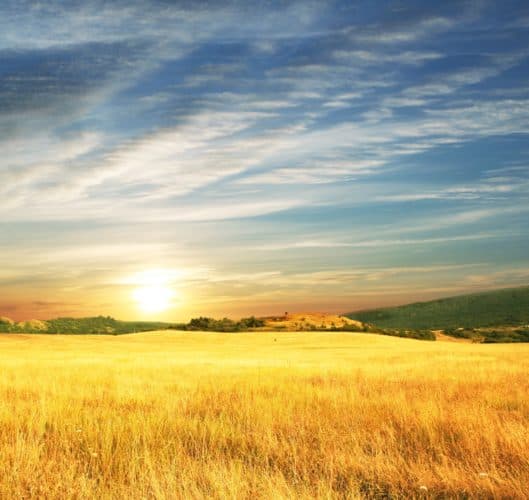
© Galyna Andrushko | Dreamstime.com
Among our findings was that changes in local temperatures appeared to play a larger role in the lives, practices and habits of the people who lived there than changes in regional, long-term temperature conditions [1]. Later, while a researcher at IIASA myself, I returned to the subject with one of our coauthors, professor Glen MacDonald of the University of California, Los Angeles, using an expanded geographic range and a more sophisticated treatment of radiocarbon dated occupation likelihoods.
We used the climate model to reconstruct prehistoric maize growing season lengths and mean annual rainfall for Fremont sites. We found that the most populous and resilient Fremont communities were at sites with low-variability season lengths; and low populations coincided with, or followed, periods of variable season lengths. This study confirmed the important dependence on climate variability; and more importantly, our results are in line with others on modern smallholder farming contexts.
More details on our latest study [2] have just been published online in Environmental Research Letters (ERL). It will become part of an ERL special issue looking at societal resilience drawing lessons from the past 5000 years. Studies like these can give useful insights on human societal responses to climate change because these ancient civilizations are, in a sense, completed experiments with complex human-environmental systems. For decision makers, who must plan early to commit resources to offset the effects of future climate change on smallholder farmers in similarly drought-sensitive, marginally productive environments, these studies indicate that year-to-year climatic variability drives occupation change more than long-term temperature change.
References:
[1] Thomson MJ, Balkovič J, Krisztin T, & MacDonald GM (2019). Simulated impact of paleoclimate change on Fremont Native American maize farming in Utah, 850–1449 CE, using crop and climate models. Quaternary International, 507, pp.95-107 [pure.iiasa.ac.at/15472]
[2] Thomson MJ, & MacDonald GM (In press). Climate and growing season variability impacted the intensity and distribution of Fremont maize farmers during and after the Medieval Climate Anomaly based on a statistically downscaled climate model. Environmental Research Letters.
Note: This article gives the views of the author, and not the position of the Nexus blog, nor of the International Institute for Applied Systems Analysis.











You must be logged in to post a comment.